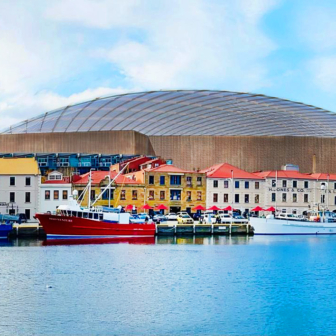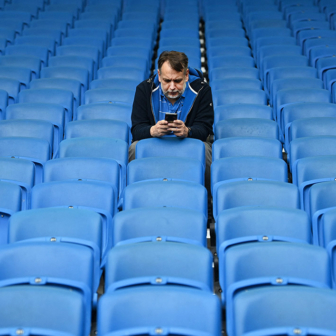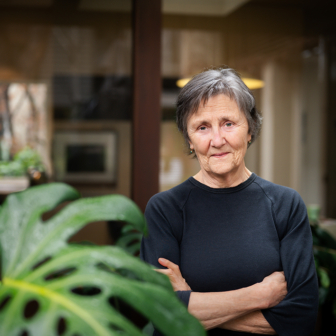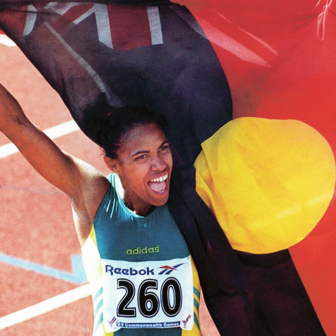Melbourne has just hosted the biggest tennis tournament the world has ever seen. A record 743,667 spectators came to Melbourne Park to watch the 2018 Australian Open — more people than have ever attended a US Open, let alone Wimbledon or Roland-Garros. And by and large, the tennis matched their expectations.
There were plenty of great matches in both the men’s and women’s draws. The crowd has always wanted Roger Federer to win the big one, and he did. Caroline Wozniacki was another popular winner when she broke through to win her first major. (Federer, by contrast, won his twentieth.) For Australia, Nick Kyrgios and Ashleigh Barty had some gritty wins. The eccentric Taiwanese player Su-Wei Hsieh, with her double-handed ping-pong shots and unreadable winners, knocked out two top players and almost made the quarterfinals. And another Asian, Korea’s Hyeon Chung, emerged as a star of the future, along with Australia’s Alex de Minaur, America’s Mackenzie McDonald, Canada’s Denis Shapovalov and (if only umpires could make her shut up) the screaming Belarusian nineteen-year-old Aryna Sabalenka — the first player to rival Sharapova on the decibel meter.
The tournament’s organisers view spectator numbers as only one metric among many. Apart from the 12.25 million who saw it on Seven — where Kyrgios’s match with third seed Grigor Dimitrov easily outrated any of Federer’s matches, including the final — the Open smashed its previous record audiences in Korea (thanks to Chung), Denmark (Wozniacki), and Romania (the unlucky runner-up, Simona Halep). Its mobile phone app was downloaded by 1.2 million people worldwide, and its total social media audience on Facebook, Instagram, Twitter and YouTube hit 4.5 million, with YouTube alone recording 26.3 million viewings.
Pardon me for not researching how those numbers compare with those of Wimbledon, Roland-Garros and the US Open — and not reviewing the entertainment, retailing and wining and dining that have become such an important part of the Open’s focus. As Pat Cash remarked, this now seems to be a tennis tournament run as part of a festival. So far as this ageing tennis nut could see, the extras have not got in the way of the tennis.
You could argue that the Australian Open today is not only the biggest of the Grand Slams, but also the best. It will never have the prestige of Wimbledon, but it has the world’s best tennis venue. Player surveys have repeatedly found that it’s the tournament the players like best, largely because it is well-run and looks after them so well. And no other Grand Slam tournament takes over its city as the Australian Open dominates Melbourne for those two weeks.
The growth of the Open since it moved to Melbourne Park in 1988 is astonishing. It has been a triumph on an international scale by a country that often struggles in global competition. Its success has many parents — Tennis Australia, successive Victorian governments, successive tournament directors and officials, the staff, the volunteers, the public, and even the sponsors — who have made it what it is today.
For those who remember the past, it is hard to believe. The last Australian Open at Kooyong in the 1980s attracted just 140,000 spectators, and almost half of them were on freebies. The TV rights paid less than $1 million. Further back, in the 1960s, when I was a Kooyong ball boy and Australia dominated world tennis, the crowds most days were in the hundreds. Even one very notable final — in which Roy Emerson downed Rod Laver in four sets — played to mostly empty stands, with only 2000 there to see it.
If you’d suggested then that the Australian Open would one day be an equal of Wimbledon or New York, you would have been rubbished mercilessly. And in 1985, when the Victorian government and the Lawn Tennis Association of Australia (the LTAA, now Tennis Australia) launched their visionary plan to move the tournament to a new stadium at Melbourne Park — the single most crucial step in the Open’s rise — the debate was dominated by its opponents.
At the time, I investigated the issues for the Age and concluded that it was a gamble with taxpayers’ money — but a gamble worth taking. Yet I remember reading the consultants’ projections of rapid growth in spectator numbers with deep disbelief. I was wrong — and so were the consultants. The growth in spectators soon far exceeded their forecasts.
No one saw it coming, not on this scale. It’s worth asking why it has succeeded so well — and where it still has room to improve.
For while Australia’s place in tennis history is secure, its hold on one of the world’s four great tournaments is not. Melbourne is not Paris, London or New York.
In some ways, the Open has fulfilled former tournament director Paul McNamee’s vision of “the Grand Slam of Asia-Pacific.” It allocates one wildcard in each singles event to an Asian player (which now goes to the winners at a tournament held in China). Many Asians visit Melbourne to see it; far more watch it at home. And while Australian players often struggle to play their best at home, many Asian players have had their best Grand Slam tournaments here: this year, including Chung (who beat Zverev and Djokovic), Hsieh (who beat Muguruza and Radwanska), and the Taiwanese and Chinese girls who dominated the junior events. An extraordinary little-known fact: since 2006, Asian players have been involved in more than half the doubles finals (men’s, women’s and mixed) at Melbourne Park. And Li Na’s emotional victory in the 2014 women’s singles remains the only singles major ever won by an Asian player.
Yet to the north is a far bigger neighbour that sees itself as the natural capital of our region. It is able and willing to spend a lot of money to attract tournaments. In the first week of the Open, we learnt that the end-of-year WTA women’s finals will move from Singapore to Shenzhen next year — with twice the prize money.
The Australian Open would be a much harder catch for the Chinese — after all, we own it — and an impossible one if it continues to be the pacesetter among the Grand Slam tournaments, as it has been for decades. Let’s see how it happened.
The history
In the age of amateur tennis, Australia’s championships had no home. In line with our egalitarian ethos, they were rotated around the larger state capitals in turn. Usually, though not always, they were played in the second half of January, at the end of a long summer of tennis dominated by the various state championships, sometimes “test matches” against foreign teams — and, in the 1950s and 60s, the Davis Cup challenge round, played between Christmas and New Year to huge crowds.
The fields were often entirely Australian. Foreign players were a treat, lured here by special invitation in the 1920s and 30s — when the LTAA brought out some of the world’s best and their compatriots to play test matches against Australia’s best, rewarding them with generous expenses and side deals (such as ghost-written newspaper columns, which make interesting reading today) — and to play Davis Cup in the 1950s and 60s.
In 1937–38 one of these was the legendary Don Budge, the world’s top player. In Adelaide that January he clubbed his way through arguably the best field of any tournament that year to win the men’s singles. As the year went on, he then did the same to win the championships of the other three great tennis nations — France, Britain and the United States. By taking all four titles, wrote New York Times tennis writer Allison Danzig, Budge had won “the Grand Slam” of tennis. The nickname stuck.
The golden era of Australian tennis in the 1950s and 60s cemented the idea that the Australian championships were one of the world’s four great tournaments. But the reality was that this Slam was a homeless orphan, rotated around four cities, and usually losing money. When tennis went pro in 1968, even the top Australians could no longer play unless their whole pro troupe came — and that cost a fortune. To afford the demands of the men, the LTAA paid the women peanuts. In 1970, when Margaret Court won her Grand Slam, her prize for winning the Australian Open was A$700. (This year’s winner took home A$4 million.)
Then, in 1972, with Australia out of the Davis Cup, Melbourne put on the tournament in the week between Christmas and New Year. And on New Year’s Day, Kooyong overflowed with a sellout crowd of spectators cheering Ken Rosewall on to his first Australian title. The tournament ran an unprecedented profit. The national titles had finally found a home.
But as prize money soared in the United States and Europe, Australia couldn’t keep up. In 1978, the men were paid US$300,000 and the women just US$35,000. Even the top Australian players refused to play in the women’s event, which was won by little-known Chris O’Neil from Newcastle.
The tournament’s future was in danger when an unlikely saviour emerged: Philippe Chatrier, the widely respected president of the International Tennis Federation. Chatrier made it his mission to restore the standing of the two struggling Slams: his own French Open, and its Australian counterpart. He formed a close alliance with LTAA president Brian Tobin, who ultimately succeeded him as ITF president.
They negotiated a deal to get the women back: if the top players committed to play, they would have their own event in November, with US$200,000 prize money. It proved a spectacular success. From 1980 on, the tournament was a real Grand Slam with the best fields it had ever seen; by 1983 its prize money was US$500,000, the same as the men.
Chatrier and Tobin negotiated a similar deal with the men, and from 1983 the Australian Open had a genuine Grand Slam field. But that created a new problem: the more the tournament grew, the more it underlined Kooyong’s limitations as a venue.
Kooyong was owned by a largely hostile private club. It had a great centre court, but its back courts had little space or seating, and its player and media facilities were designed for the 1920s. Court One was so small that when John McEnroe survived a thrilling five-set battle with young Henri Leconte in 1985, barely 1500 spectators could squeeze in to see it.
To survive, this tournament had to innovate. This time its rescuer was Labor premier John Cain and his government. Cain quickly grasped that it would be impossible to stage a full-size 128-player tournament at Kooyong; a new venue was needed, or Melbourne could lose the event. His government selected Flinders Park, then a little-used grassland between Olympic Park and the railway lines, as the new venue.
Storms of protest broke from every interest group: the rail unions, the Melbourne City Council, Jeff Kennett (who vilified the project as “Cain’s cathedral”), conservationists, the Kooyong club, the Olympic Park management. To their great credit, Cain and his ministers stood firm against the confected outrage. The Victorian government became the tournament’s new landlord, and built for it a complex that was, as Chris Evert told us when it opened in 1988, the best in the world.
The Open’s assets were its site, its willingness to innovate, and its focus on player welfare. The retractable roof on Rod Laver Arena (and later, the other two main courts) allowed play to continue in wet weather — and, more controversially, on days of extreme heat. High-quality lighting allowed it to stage separate night sessions. Tunnels to the main courts gave the players security from human pests. And the spaciousness of the complex, once stage two was added in 1996, gave it options that Wimbledon or Roland-Garros could not match.
Paul McNamee, the tournament director from 1994 to 2006, instituted a kaizen culture of continuous innovation, recounted in his autobiography Game Changer. He persuaded Jeff Kennett (a convert once he became premier) to build the 10,000-seat stadium we know as Hisense Arena. After he came up with the “the Grand Slam of Asia-Pacific” brand and the Asian wild card, television coverage in Asia massively increased. Channel Seven was browbeaten into upgrading its B-grade coverage into something that is now world-class.
A ten-point tie breaker was introduced in place of a third set to shorten mixed and junior doubles matches — an innovation that has now spread worldwide. The two main stadiums were named after Rod Laver and Margaret Court. And after bad line calls at crucial points derailed Alicia Molik in 2005 and Jelena Dokic in 2006, Hawk-eye was introduced to become the ultimate line judge in the main arenas — another innovation that has spread worldwide.
There are more innovations that McNamee’s successor Craig Tiley could reel off, although in recent years they seem to have less to do with the tennis than with the sideshows — the off-court entertainment, eating, drinking and shopping designed to attract those with limited interest in tennis.
These days, the trendsetter is a new men’s tournament created by the ATP in Milan in November: its Next Gen finals for the eight best players twenty-one and under (which was won by Hyeon Chung). Designed to speed up tennis to meet the demands of busy people who see the matches as too time-consuming, it has introduced a spate of new rules, including:
• Warm-ups limited to five minutes.
• No service lets: if the serve hits the net on its way in, you play it anyway.
• A shot-clock to limit players to twenty-five seconds between points. (That limit applies now, but is widely ignored, especially by world number one Rafael Nadal.)
• Each set to be first to four games, with a tie breaker at 3–3. (Many of us don’t like that one.)
• At deuce, you play a sudden-death point to decide the game.
• Players can communicate on headphones with their coaches at the end of each set, and have access to match statistics on their tablets.
Some of these innovations will spread into the big tournaments soon. Expect the Australian Open to be one of the early adopters.
But our tournament has two unique problems.
The date — and the heat
Some people gripe about having the Australian Open in January (which to me seems a bit like griping about Australia being all the way down here). By contrast, Roger Federer sees it as an asset, arguing that the start of the year is when players are keenest to make an impact. And if you tried moving it to another month, it would be in serious trouble.
The problem is that the Open comes after a long break in November–December, followed by just two weeks of lead-in tournaments for players to get match fit. Some of the upset results in the first week of the this year’s Open showed that some stars were not yet ready.
Wimbledon used to have the same problem. Only two weeks separated the end of the French Open (on clay) from the start of Wimbledon (on grass). Wimbledon campaigned long and hard, and finally persuaded the ATP and the WTA to adjust their calendars to allow three weeks’ preparation on grass.
We should do the same. A few years ago, Tennis Australia offered to put the tournament back a week to allow three weeks’ preparation. Alas, the tournaments in February refused to change their dates, so the ruling bodies took no action. But it would improve the tournament, and the calendar can make space for it. We should keep pushing for it.
Then there’s the heat. Tennis lives in a year-round summer, but rarely experiences anything like a Melbourne heatwave. Tournament referee Wayne McEwen is authorised to stop play on outside courts when he judges the heat and/or humidity to be excessive, and to close the roofs of the three main stadiums so play continues indoors. Despite grumbling among players and purists, that policy is now generally accepted. But this year McEwen implemented it only on the last day of the tournament.
On the first Thursday and Friday, play went on as the mercury hit forty degrees in the shade, and hotter still on the stadium courts, where the Plexicushion surface traps the heat under the players’ feet. Players visibly wilted on court. Matches were decided not on skill but on how well the players’ bodies could cope with playing in a furnace. Some collapsed and had to forfeit. Some just let the match slip away. And others survived: exhausted, blistered, and wondering why.
Why wasn’t play stopped, or the roofs closed? Tennis Australia says it wasn’t humid enough. It measures player discomfort by a combination of heat and humidity. And this was a dry Australian heatwave, of the kind we’ve experienced at this tournament since it began.
That’s true. Spend two weeks in Melbourne in January, and you are bound to experience a heatwave. We had one when I was a ball boy: Lesley Turner (now Lesley Bowrey) fainted in the heat, and had to be carried off the court. This tournament has always been, in part, a test of players’ physical resilience.
But it’s a tougher test now. The average January maximum in Melbourne this decade has been 1.2 degrees hotter than it was back then; on current trends, it will only get worse. And the players are no longer playing on cool grass, but on hot synthetic courts.
The Open team has set the bar too high. Gaël Monfils and Novak Djokovic were gasping for air on Rod Laver Arena in the merciless heat, while players like Alizé Cornet and Markéta Vondroušová wilted in the cauldron of Hisense Arena. It shouldn’t be like that. Play can continue under the roofs of the show courts. Matches on outside courts can be postponed till evening. It would make the tournament more humane for players and spectators.
There were other controversies. Some demanded that Margaret Court Arena be renamed, apparently because they cannot tolerate her intolerance of them. Tennis Australia is normally very PC, but it wouldn’t buy that one. And then there is the sad story of Bernard Tomic, another prodigy who was enslaved to a tennis career in childhood, and now cannot find a way to enjoy it and accept the self-discipline it requires.
It would be sad for Tomic and for Australian tennis if we lost his magical creativity on court. Davis Cup captain Lleyton Hewitt and Tennis Australia should understand what is behind his troubles, and keep the door open for him, whatever the provocation.
For now, though, Tennis Australia can relax. It has just given us a tournament that was, in most ways, the state of the art.•




